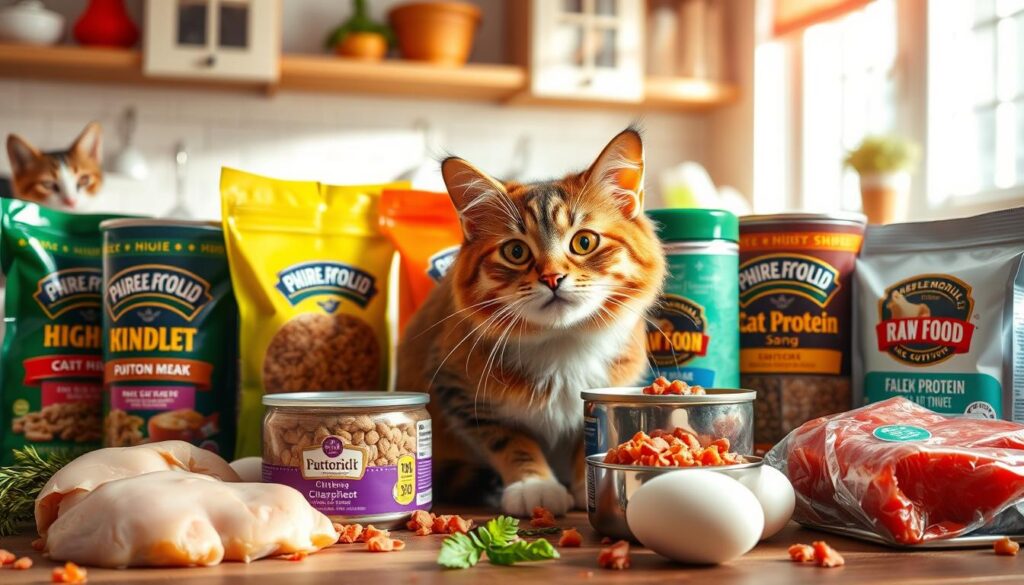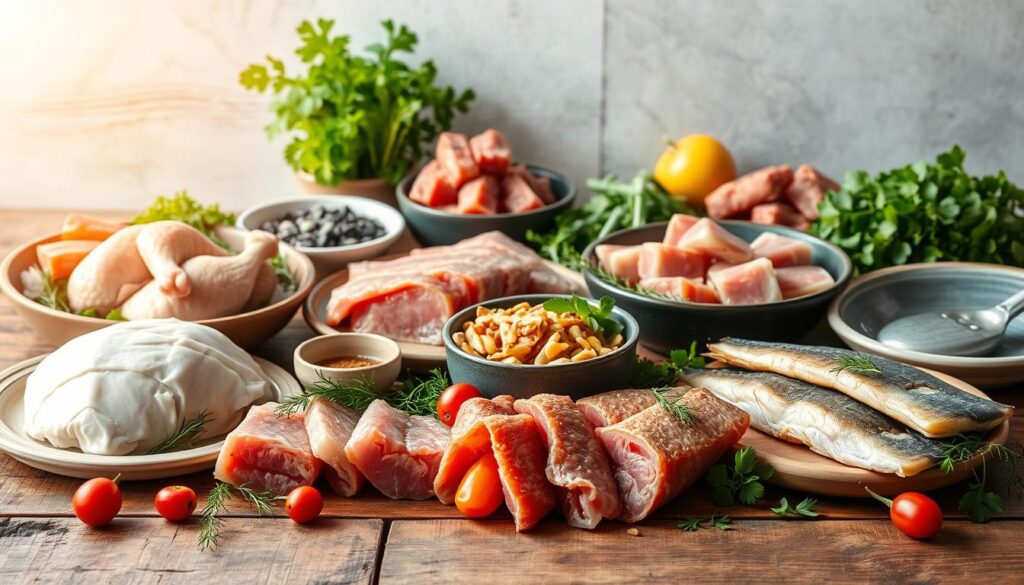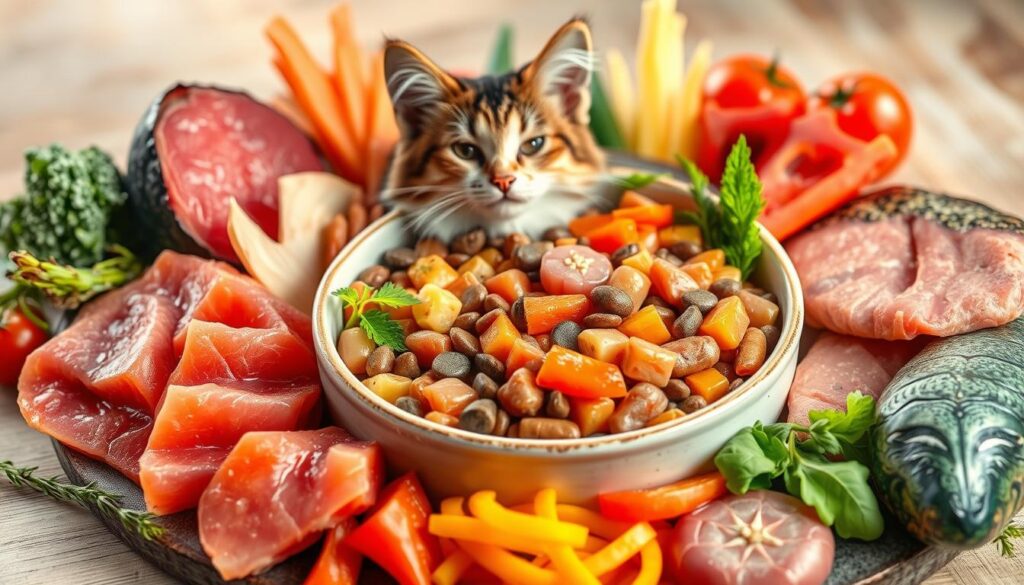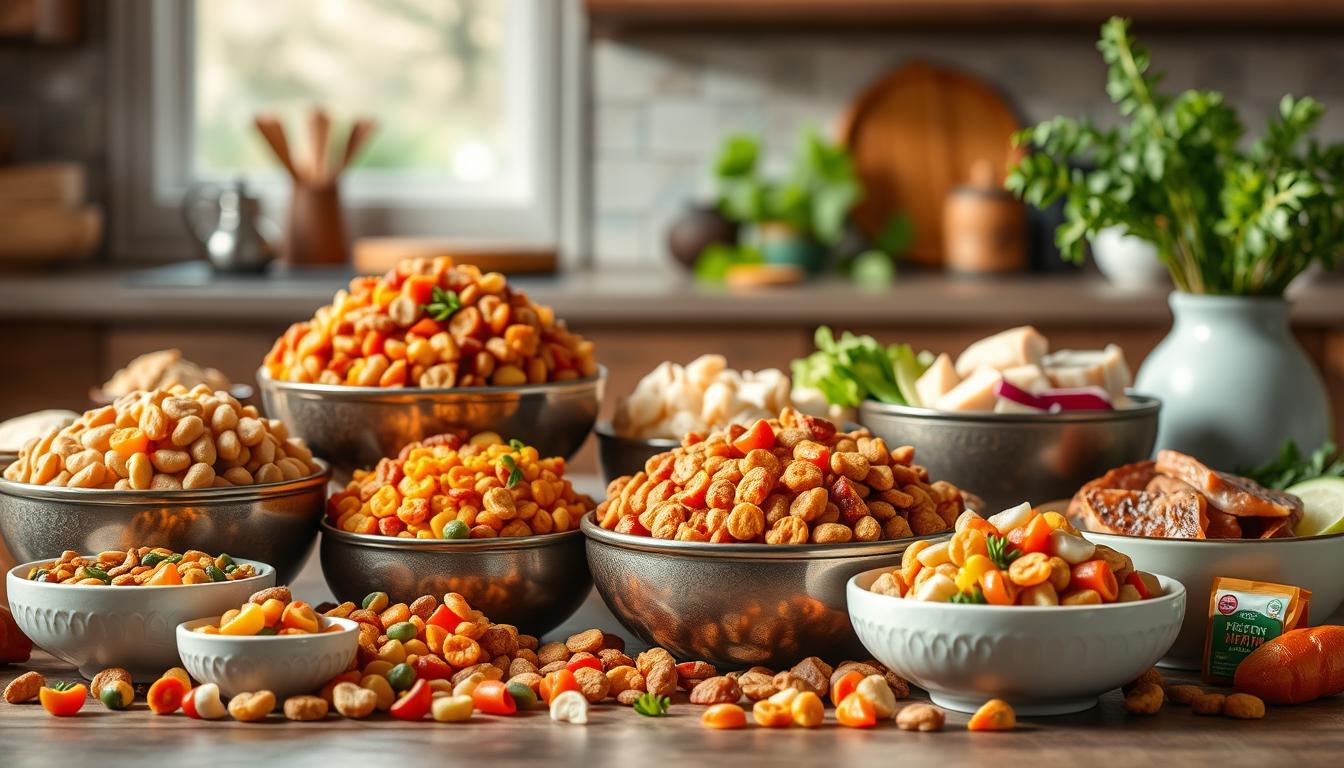As a cat owner, it’s key to give your cat the best high-protein diets. This is vital for their health and happiness. High-protein cat food helps keep their muscles strong, their energy up, and their health in check. With so many choices, picking the right one can feel daunting.
Knowing how important protein is in your cat’s diet is the first step. The best high-protein diets give your cat the nutrients they need for top health. In this guide, we’ll dive into high-protein cat food diets. We’ll help you understand how to choose the best for your cat.
Key Takeaways
- Best high-protein diets for cats are essential for maintaining muscle mass and energy levels
- Cat food with high protein is designed to meet your cat’s nutritional needs
- Understanding protein requirements is crucial for making informed decisions about your cat’s diet
- High-protein diets can improve your cat’s overall health and well-being
- Choosing the right high-protein cat food can be overwhelming, but with the right knowledge, you can make the best decision for your cat
Understanding Your Cat’s Protein Requirements
Cats are natural meat-eaters, so their diet should match. High protein cat foods are key for their health. They need protein for strong muscles, bones, and organs.
A cat’s protein needs change with age, weight, and activity. They need at least 30% protein, sometimes up to 50% or more. Knowing about different breeds helps choose the right food.
Important amino acids like taurine and arginine are vital for cats. These are found in good protein sources like chicken, salmon, and beef. Choose cat food with these ingredients and high protein content.
Natural Carnivorous Needs
Cats are built to eat a lot of protein and fat, not carbs. Their body is made to digest lots of protein easily. This makes protein a must in their diet.
Daily Protein Requirements
Protein needs change with a cat’s life stage and lifestyle. Kittens need more, while older cats need less. Talk to your vet to find the right diet for your cat.
Essential Amino Acids for Cats
Important amino acids like taurine, arginine, and lysine are crucial for cats. They are found in quality protein sources. These amino acids help keep your cat healthy and happy.
Why High-Protein Diets Matter for Feline Health
Choosing the right cat food is key for a cat’s health. Cats need a lot of protein because they are natural meat-eaters. High-protein cat food gives them the amino acids they need for muscles and a strong immune system.
A high-protein diet is vital for cats. It helps them keep their muscles strong and feel their best. Without enough protein, cats can lose muscle and have a weak immune system. A high-protein diet ensures cats get the nutrients they need for good health.
High-protein diets offer many benefits for cats, including:
- Supports muscle growth and repair
- Boosts immune function
- Supports overall vitality and energy levels
When picking the best cat food, look for high-protein options. A protein-rich diet supports your cat’s health and happiness for years to come.
Signs Your Cat Needs More Protein in Their Diet
As a cat owner, it’s key to know when your pet needs more protein. High protein diets are vital for your cat’s health. A premium cat food with protein ensures they get the nutrients they need.
Look out for signs like weight loss, poor coat, or less muscle. These can mean your cat’s diet lacks protein. Research in veterinary nutrition shows protein is crucial for cats, especially since they’re obligate carnivores.
Physical Symptoms
- Weight loss or poor weight gain
- Poor coat condition or dull fur
- Lack of muscle mass or tone
Behavioral changes can also show your cat needs more protein. If they’re hungrier or less active, it might mean their diet is off. High-protein diets can boost their energy and help them thrive.

Energy Level Indicators
A cat’s energy level can show if they need more protein. If they seem tired or lack energy, it’s a sign. By noticing these signs and adjusting their diet, you can help them live a happy, healthy life.
Best High-Protein Diets for Cats: Top Options for Every Budget
Providing your cat with the best nutrition is key. Quality protein cat food is crucial because cats are natural meat-eaters. We’ll look at the top high-protein diets for cats, fitting all budgets.
Top brands like Hill’s Science Diet, Royal Canin, and Wellness offer great options. They have different protein levels to match your cat’s needs. For instance, Hill’s Science Diet Adult Indoor Cat Food has 30% protein, while Royal Canin’s Indoor Cat Food has 34%.
When picking a best high-protein diet for cats, consider these points:
- Protein content: Choose foods with high protein from animal sources like chicken, salmon, or beef.
- Ingredient quality: Opt for foods with whole, named ingredients instead of generic terms like “meat” or “by-products”.
- Price: Best high-protein diets for cats vary in price. Pick a food that fits your budget and meets your cat’s needs.
Choosing a quality protein cat food that fits your cat’s needs is important. It helps them stay happy and healthy. Always talk to your vet before changing your cat’s diet.
Comparing Wet vs. Dry High-Protein Cat Foods
Choosing the right cat food is important for your pet’s health. You must decide between wet and dry food. Each has its own benefits and drawbacks. The choice depends on your cat’s needs and what they like.
Wet cat food has more moisture than dry food. This is good for cats with health issues like kidney disease. Dry food is easier to store and can be cheaper.
Moisture Content Benefits
Wet cat food has 75-80% moisture, while dry food has 10-15%. This extra moisture helps with urinary health. It also makes food more appealing to cats who are finicky.
Protein Concentration Differences
Both wet and dry cat food can be high in protein. But, wet food usually has more protein. This is good for cats needing lots of protein. Still, look at the food’s overall nutrition, including protein quality and other nutrients.
Cost Comparison
Dry cat food is cheaper than wet food, especially in bulk. But, think about the food’s value, not just price. High-quality, protein-rich foods may cost more but offer better health benefits for your cat.
Raw Diet Options for Maximum Protein Intake
Raw diets are a great choice for cat owners who want high-quality protein for their pets. These diets are key for keeping cats healthy. A well-made raw diet gives cats the nutrients they need for growth and health.
Raw diets can make cats’ digestion better, boost their energy, and make their coats shine. But, there are risks like bacterial contamination and not getting enough nutrients. It’s important to talk to a vet to make sure it’s right for your cat.
When adding raw food, start small to avoid upset stomachs. Begin by mixing a little raw food with their regular food. Then, slowly add more raw food. Some good raw diet options include:
- Freeze-dried raw meat
- Raw meat patties
- Homemade raw diets using fresh meat and supplements

To make a raw diet work, it must be well-planned and balanced. With a vet’s help and research, you can give your cat a diet rich in protein. This supports their health and happiness.
How to Read Cat Food Labels for Protein Content
Choosing the right cat food means knowing how to read labels. Look at the guaranteed analysis section for protein, fat, and nutrient percentages. Make sure the label lists specific protein sources like chicken or salmon, not just “meat” or “by-products”.
A good cat food should have at least 30% crude protein. Check the ingredient list for protein sources like chicken meal or fish oil. Avoid foods with too many fillers, artificial preservatives, or low-quality proteins.
- Protein content: Look for foods with high protein levels from named sources, such as chicken or beef.
- Ingredient quality: Choose foods with whole ingredients, rather than fillers or by-products.
- Preservatives: Opt for foods with natural preservatives, rather than artificial ones.
By learning to read cat food labels, you can pick the best food for your cat. Look for high protein content and quality ingredients.
Transitioning Your Cat to a High-Protein Diet
When you start your cat on top high-protein cat diets, do it slowly. Mix a little of the new food with their old diet. Then, slowly add more of the new food over 7-10 days. This helps their stomach get used to the new food and protein.
Choose best high-protein diets for cats that have lots of animal protein. Foods like chicken, salmon, or beef are good. These give your cat the amino acids they need to stay healthy. Some cats might be finicky, so make sure they like the new food.
- Start by giving them small amounts of the new food as treats. This lets them get used to the taste and feel.
- Slowly add more of the new food to their diet over time.
- Watch for any signs of upset stomach, vomiting, or feeling tired. If you see these, slow down the change.
By following these steps and picking the right top high-protein cat diets, you can make the switch to a better diet for your cat. Always talk to your vet if you have any questions about your cat’s diet or health.
Special Considerations for Different Life Stages
Cats change as they grow and age, needing different nutrients. Premium cat food with protein is key for their health. It’s vital to think about your cat’s life stage.
Kittens and Growth
Kittens need more protein for growing strong. Cat food with high protein supports their fast growth and energy. A balanced diet with protein helps kittens build strong muscles and bones.
Adult Maintenance
Adult cats need a moderate protein amount for health. Premium cat food with protein supports their energy and muscle. Choosing high-quality food is crucial for their nutrition.
Senior Cat Requirements
Senior cats might need less protein due to kidney issues. Yet, they still need a balanced diet. Cat food with high protein can be good, but a vet’s advice is essential for their diet.

Considering your cat’s life stage and protein needs is important. Choose premium cat food with protein that fits their needs. Always talk to a vet for the best advice.
Common Myths About High-Protein Cat Foods
There are many myths about feline diets with high protein. One myth is that high-protein cat foods harm a cat’s kidneys. But, this is not true. These foods actually support kidney health by providing important amino acids.
Another myth is that high-protein foods make cats gain weight. It’s true that some high-protein foods have more calories. But, many high-protein cat foods are low in fat and calories. They are perfect for cats who need to lose weight or stay healthy.
Some people worry about the cost of high-protein cat foods. It’s true that some are pricier than others. But, the health benefits for cats are worth it. Choosing a high-protein food rich in amino acids and low in fillers supports your cat’s health.
- Look for cat foods that are labeled as “high-protein” or “protein-rich”
- Choose cat foods that are made with high-quality protein sources, such as chicken or salmon
- Avoid cat foods that are high in fillers or by-products
By debunking these myths and choosing the right cat food, you can help your cat thrive. Whether it’s for kidney health or a nutritious diet, there are many good options out there.
Potential Risks and When to Consult Your Vet
High-quality protein diets are key for your cat’s health. But, there are risks to watch out for. Knowing these risks helps keep your cat safe and healthy.
Health Conditions to Consider
Some health issues might mean your cat needs a different diet. For instance, cats with kidney disease might need less protein. Always talk to your vet to find the right diet for your cat.
Warning Signs
Watch for signs that your cat might need vet help. Look out for vomiting, diarrhea, or feeling very tired after trying new high-protein foods. If you see these signs, call your vet to make sure your cat is eating the best food.
Knowing the risks and talking to your vet helps give your cat the right diet. Always pick the best cat food for protein to keep your cat healthy.
Supplementing a High-Protein Diet
For your cat’s best nutrition, quality protein cat food is key. Some owners might add extra nutrients to boost health. Top high-protein cat diets can get a boost from omega-3 fatty acids for skin and coat health. Probiotics also help with digestion.
A balanced diet with quality protein cat food should always be first. Supplements should just add to, not replace, a good diet. Benefits of adding supplements to a top high-protein cat diet include:
- Enhanced skin and coat health
- Improved digestion and reduced risk of digestive issues
- Boosted immune system
Always talk to your vet before adding supplements. They can guide you on what’s best for your cat. A top high-protein cat diet with the right supplements can keep your cat healthy and happy.
Always make sure your cat’s diet is balanced and includes quality protein cat food. Use supplements wisely to support their health and happiness.
Cost-Effective Ways to Boost Protein Content
Looking to give your cat the best without spending a lot? There are ways to do it. Making homemade treats like cooked chicken or fish is a good start. It adds variety and ensures they get enough protein.
Mixing high-protein toppers with their regular food is another smart move. Toppers like canned tuna or salmon can make their meals more protein-rich. Remember to introduce new foods slowly to avoid upset stomachs.
Here are more ways to boost your cat’s protein without spending a lot:
- Adding eggs or cottage cheese to their meals
- Using protein-rich canned foods as a topper
- Creating homemade cat food with high protein using affordable ingredients
These tips help you give your cat the best protein without breaking the bank. Always talk to your vet before changing your cat’s diet. This ensures they get the right nutrition for their health.
Empowering Your Cat’s Health Through Protein-Rich Nutrition
A high-quality, protein-rich diet is key for your cat’s health. Choosing the right cat food ensures they get the amino acids and nutrients they need. This helps keep their muscles strong, coat shiny, and energy high.
Cats are obligate carnivores, so their diet is different from other pets. By picking the best protein-rich cat foods, you’re helping your cat stay healthy. They’ll show their gratitude with happy purrs and playful behavior.
FAQ
What are the benefits of a high-protein diet for cats?
A high-protein diet helps cats stay lean and healthy. It boosts their immune system and energy. Cats, being natural meat-eaters, need lots of animal protein in their food.
How much protein do cats need in their diet?
Cats need a lot of protein, about 30-45% of their diet. This amount changes based on their age, how active they are, and their health.
What are the signs that my cat needs more protein in their diet?
Signs your cat needs more protein include losing weight, a dull coat, and being hungry all the time. They might also seem tired or less energetic. Watch for these signs and adjust their food as needed.
What are the best high-protein cat food options?
Many cat foods are high in protein, from premium to more affordable options. Look for foods with real meat, poultry, or fish as the main protein source.
How do I transition my cat to a high-protein diet?
Slowly introduce a high-protein diet to avoid upset stomachs. Mix the new food with their old food and gradually increase the new food’s ratio. Do this over several days or weeks, depending on your cat’s acceptance.
Are there any special considerations for different life stages when it comes to high-protein diets?
Yes, protein needs change with a cat’s life stage. Kittens and growing cats need more for growth. Senior cats might need less due to health issues like kidney problems.
Are there any risks associated with high-protein diets for cats?
High-protein diets are usually safe for cats. But, some health issues might require vet advice. Always watch your cat’s health and talk to your vet if you’re worried.
How can I supplement a high-protein diet for my cat?
Supplements like omega-3 fatty acids and probiotics can enhance a high-protein diet. But, always check with your vet first. They’ll make sure the supplements are right for your cat.

